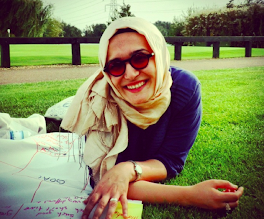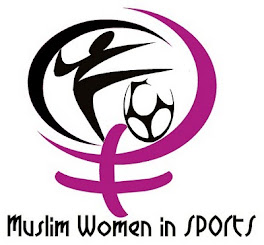Here, Mohammad Abbas discusses advancements made in the world of sport which will now better enable more Muslim women, who want to cover their hair whilst participating in sports, to enter sport. The piece is generally quite interesting and is amongst a hand full of articles that I have come across that actually alludes to the stresses and strains of 'skimpy' sports attire as a 'problem' for other women (not just Muslim women as it too often portrayed). What I am disgruntled by, however, is the actual title which implies that the hijab was a hurdle. Of course this naturally leads me to respond: 'was Hijab' a hurdle for Muslim sportswomen, or was it a prevailing logic which persistently and categorically chose to view the Hijab as 'problematic' and 'out-of-place' in sport the real hurdle? I recall having conversations with many of my sports students about the idea of a sport hijab and I also recall with dismay their reluctance to allow it to be worn (for a number of reasons, the most commonly cited one of course being that of health and safety and of uniform regulations). Yet when I cited that the same uniform policies have allowed players to wear caps, and turbans - even glasses on a few occasions - then, they really do begin to ponder, but still press ahead with the view that 'religion should have no place in sport'. I do not veil and am a Muslim woman, but can empathise with those women who want to wear it and have in my work, allowed them to express their identities and their religion through the use of bandanna's and colourful scarves. Yet, I am amazed at how it is that a sporting word - as advanced as it now is - could not view the idea of a sports hijab as a new and creative invention. And Muslim women were re-designing and wearing such attire long before an official regulator rubber-stamped it as 'safe'. Why are we not celebrating or commending their creativity and intuitiveness? Why have we not reported these women as being central to the revolutions that are taking place in the world of sport, and only see the rubber-stamping as progress?
Aug 1 (Reuters) - Headscarf-wearing Muslim women are making strides at the Olympic Games, a year after the Iranian women's soccer team broke down in tears at having to withdraw from a qualifying match because they wore hijabs.
Worn under a fencing mask, wrapped tightly in an elasticated bun for weightlifting or styled into a cap for shooting, the controversial headgear is finally winning acceptance from sporting associations.
This week judo sports authorities and the Saudi Olympic Committee confirmed they had reached an agreement allowing a Saudi judoka to compete with her hair covered, and last month soccer's rule makers also lifted their ban on the hijab.
The International Judo Federation had initially said Wojdan Ali Seraj Abdulrahim Shaherkani could not compete in a headscarf, which would have been a huge blow to aspiring Saudi sportswomen: she and runner Sarah Attar are the country's first women to compete at any Olympics.
"This agreement shows that being a modest Muslim woman is no barrier to taking part in sport. It shows the inclusiveness of the Olympic spirit," said Razan Baker, spokeswoman for the Saudi Olympic Committee.
Islamic states Brunei and Qatar have also sent female athletes to the Games for the first time.
The modest forms of dress demanded by more conservative societies or chosen by more pious women have long been a brake on female participation in sport, not only for Muslims but also for women of other faiths.
"Many Muslim women both in Britain and around the world are excluded or discouraged from taking up sports owing to their desire to maintain stricter standards of modesty than sports clothes allow," said Emma Tarlo of the department of anthropology at Goldsmiths, University of London.
"And Muslims are not alone. A number of women from Hindu, Sikh, and orthodox Jewish backgrounds as well as people with weight issues are put off swimming by the skimpiness of most existing styles of swimwear," she added.
ISLAMIC SPORTSWEAR
Luckily, a number of designers are turning their attention to women keen to take part in sport while wearing modest attire.
In the Netherlands, designer Cindy van den Bremen has designed a range of headwear for sporty Muslim women dubbed "capsters".
"The concept is based on the idea to give Muslim girls and their gym teachers in the Netherlands a safe alternative for the traditional hijab to wear during gym class," Bremen says on her website.
Online vendor thehijabshop.com carries capsters under its "sporting range" under the categories "skate", "aerobics", "outdoor" and "tennis", and touts the headgear as designed not to shift or tear during physical activity.
British-based Modestly Active's line of Islamic sports gear includes swimwear and martial arts, basketball and soccer kits, which the company says have been specially designed with the latest sports technology to be breathable and durable.
Ismail Sacranie said he and his wife founded the company in 2007 after designing special clothing for their sports-mad daughters. Since then the response had been "phenomenal", with orders from all over the world.
"We saw the restrictions that were faced by our own children. I have three daughters of my own, they're just like any other teenagers, and why should a piece of fabric restrict them?" he said.
"My daughters were outraged and annoyed beyond comprehension at the fact that simply because somebody's covering their hair they're alienated," he added.
Now one of his daughters, inspired by the British Olympic female soccer team's wins over New Zealand and Brazil, is determined to join the national soccer team herself, where she will be able to wear her headscarf.
"It's a huge statement for mankind to overcome these kind of barriers, and let the enthusiasm and professionalism of a person speak, rather than what they're wearing," Sacranie said. (Editing by Mark Trevelyan)





